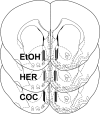Specific alterations of extracellular endocannabinoid levels in the nucleus accumbens by ethanol, heroin, and cocaine self-administration
- PMID: 17409233
- PMCID: PMC6672416
- DOI: 10.1523/JNEUROSCI.4403-06.2007
Specific alterations of extracellular endocannabinoid levels in the nucleus accumbens by ethanol, heroin, and cocaine self-administration
Abstract
Ethanol and opiate self-administration are sensitive to manipulations of cannabinoid CB1 receptor function and, from this, a role for the endogenous cannabinoid system in the modulation of drug reward has been hypothesized. However, direct in vivo evidence of drug-induced alterations in brain endocannabinoid (eCB) formation has been lacking. To address this issue, we explored the effect of drug self-administration on interstitial eCB levels in the nucleus accumbens (NAc) shell using in vivo microdialysis. Ethanol, heroin, and cocaine were compared because the rewarding properties of ethanol and heroin are reduced by CB1 receptor inactivation, whereas cocaine reward is less sensitive to these manipulations. Ethanol self-administration significantly increased dialysate 2-arachidonoylglycerol (2-AG) levels with no concomitant change in dialysate anandamide (AEA) concentrations. Conversely, heroin self-administration significantly increased dialysate AEA levels, and induced a subtle but significant decrease in dialysate 2-AG levels. In each case, the relative change in dialysate eCB content was significantly correlated with the amount of drug consumed. In contrast, cocaine self-administration did not alter dialysate levels of either AEA or 2-AG. Local infusion of the CB1 antagonist SR 141716A into the NAc significantly reduced ethanol, but not cocaine, self-administration. Together with our previous observation that intra-NAc SR 141716A reduces heroin self-administration, these data provide novel in vivo support for an eCB involvement in the motivational properties of ethanol and heroin but not cocaine. Furthermore, the selective effects of ethanol and heroin on interstitial 2-AG and AEA provide new insight into the distinct neurochemical profiles produced by these two abused substances.
Figures




References
-
- Bardo MT. Neuropharmacological mechanisms of drug reward: beyond dopamine in the nucleus accumbens. Crit Rev Neurobiol. 1998;12:37–67. - PubMed
-
- Basavarajappa BS, Hungund BL. Cannabinoid receptor agonist-stimulated [35S]guanosine triphosphate gammaS binding in the brain of C57BL/6 and DBA/2 mice. J Neurosci Res. 2001;64:429–436. - PubMed
-
- Bazinet RP, Lee HJ, Felder CC, Porter AC, Rapoport SI, Rosenberger TA. Rapid high-energy microwave fixation is required to determine the anandamide (N-arachidonoylethanolamine) concentration of rat brain. Neurochem Res. 2005;30:597–601. - PubMed
-
- Berke JD, Hyman SE. Addiction, dopamine, and the molecular mechanisms of memory. Neuron. 2000;25:515–532. - PubMed
-
- Brodie MS, Dunwiddie TV. Cocaine effects in the ventral tegmental area: evidence for an indirect dopaminergic mechanism of action. Naunyn Schmiedebergs Arch Pharmacol. 1990;342:660–665. - PubMed
Publication types
MeSH terms
Substances
Grants and funding
LinkOut - more resources
Full Text Sources
Research Materials
